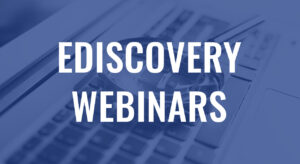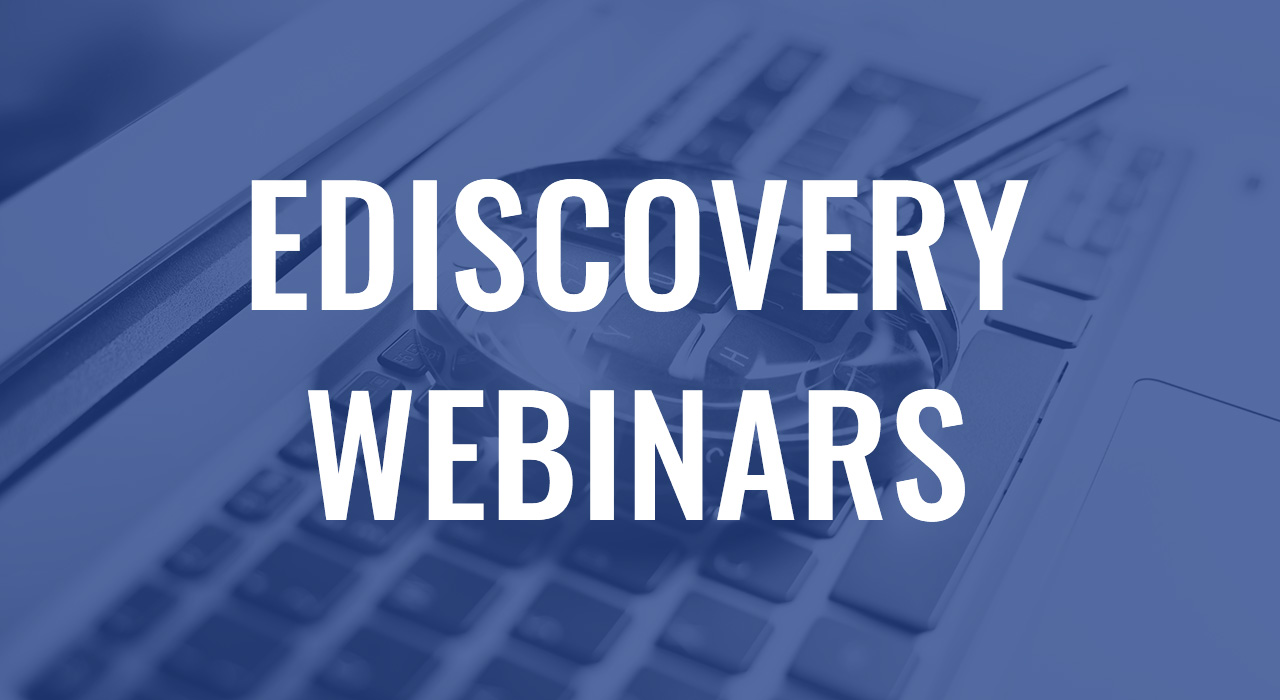A Boutique Lawyer’s Guide to Managing Document Intensive Cases
Boutique law firms and lawyers are on the rise and handling an increasing percentage of complex and document-intense cases. Practicing in a boutique firm is
Boutique law firms and lawyers are on the rise and handling an increasing percentage of complex and document-intense cases. Practicing in a boutique firm is

Email communications continue to play a big role in eDiscovery and have contained critical evidence in support of malpractice claims. Join us for this informative session where you’ll learn the seven deadly sins of email as well as best practices to help you avoid malpractice claims. You’ll also learn how to use the seven deadly sins of email in discovery to help you identify evidence in document review.

The proliferation of ESI sources requires an approach that expands beyond email. Understanding the IT profile of the custodian and utilizing a data map is instrumental in identifying the key sources of ESI. The growth in apps, collaboration platforms, cloud storage and the Internet of Things (IoT) devices has resulted in the exponential growth in quantity and complexity of ESI sources.
Increasingly, non-email communications make up critical evidence in modern litigation. Text messaging and social media are used regularly by case participants and witnesses in addition to traditional email. Companies are supporting instant messaging and other collaborative applications in addition to email for internal communications.

Increasingly, non-email communications make up critical evidence in modern litigation. Text messaging and social media are used regularly by case participants and witnesses in addition to traditional email. Companies are supporting instant messaging and other collaborative applications in addition to email for internal communications.

With hundreds of billions of emails exchanging hands daily, each with its own unique metadata, container folder and possible attachments to examine, special consideration must be given to email at every stage of eDiscovery. Litigators and paralegals must effectively review ESI (Electronically Stored Information) during production, and great care must be taken to avoid producing confidential information.

Approaching mobile collection with conventional methods can result in run-away eDiscovery costs, lost data and the careless oversight of evidence. Traditional collection methods, including discovery orders, have not evolved to include the unique file structure and ESI channels that exist in mobile devices.

Preventing the inadvertent disclosure of privileged information in litigation is increasingly challenging. Technological advancements have ushered in varying mediums of information storage and exchange, that thoroughly document privileged communications. This requires additional review resources to protect confidentiality and privilege.

With multiple terabytes of ESI, numerous data custodians and technical expertise required, attorneys litigating a patent or trade secret claim face unique eDiscovery challenges.
Native files refer to electronically stored information (ESI) stored in the format originally used by the fact witness or other custodian, without conversion to TIFF, PDF or other paginated formats for review. Examples are Word, Excel, and Powerpoint or Outlook Email.
Native files refer to electronically stored information (ESI) stored in the format originally used by the fact witness or other custodian, without conversion to TIFF, PDF or other paginated formats for review. Examples are Word, Excel, and Powerpoint or Outlook Email.
Legal teams in law firms and in-house legal departments attempting to conduct sophisticated legal document review on the Mac face some considerable obstacles. Most popular electronic discovery and legal document management applications are Windows based requiring review on another platform.

With the exponential increase in data sources and increasingly tech savvy custodians, digital forensics has quickly come to the forefront in order to identify and collect the evidence required for your cases.
Lexbe’s Model ESI Agreement Order is a 13-page sample eDiscovery protocol that stipulates the requirements and procedures for ESI preservation, collection and production in eDiscovery.

Preventing the inadvertent disclosure of privileged information in litigation is an increasing challenge. Technological advancements have ushered in varying mediums of information storage and exchange that thoroughly document privileged communications. This requires additional review resources to protect confidentiality and privilege.

The promise of high utility applications in the eDiscovery space, particularly AI, has opened up new possibilities and fueled expectations about the speed, accuracy and efficiency of performing evidentiary review.

Mobile devices are everywhere. Within the last decade or so, smart phones have become not only a staple in our society, but arguably a necessity. There are two major players in the smartphone game, Android and Apple.
Preventing the inadvertent disclosure of privileged information in litigation is increasingly challenging. Technological advancements have ushered in varying mediums of information storage and exchange that thoroughly document privileged communications. This requires additional review resources to protect confidentiality and privilege.

Increasingly, non-email communications make up critical evidence in modern litigation. Text messaging and social media are used regularly by case participants and witnesses in addition to traditional email.

Using data maps in custodian interviews is an instrumental step to help locate evidence early in the case and establish leverage for building your best

eDiscovery is continuously evolving with each new year adding layers of complexity. Beyond the exponential year-over-year growth of Electronically Stored Information (ESI), the sources of ESI continue to diversify. Attorneys failing to stay up to date on the quickly evolving landscape risk missing evidence, wasting money and losing cases. This webinar provides an overview of the new and emerging challenges lawyers will face in 2020 as well as describing solutions for those willing to stay ahead of the curve.

Increasingly lawyers are taking advantage of technology to practice in specialized boutique and smaller firm environments. But the rapidly growing size of collections of electronically stored information (ESI) presents an increasingly difficult challenge: How to effectively manage these resource-hungry cases without large firm support?
To schedule a personal demo, get a price quote, or free consultation, please complete this form below and one of our expert sales professionals will contact you. If you prefer, you can contact us directly at 1-800-401-7809 x22 or at [email protected].
All contact information is kept confidential. View our privacy policy.